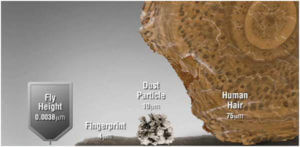Why You Should Never Open a Failed Hard Drive

Small Particles Cause Damage
When a failed hard drive is making a clicking or isn’t spinning there is a temptation by many customers to open the drive itself.
A hard drive that is in need of data recovery should never be open. The cover of your hard drive sound never be removed. Even the tiniest specks of dust can mean the end of your data and drive forever.
Perhaps the thinking behind the desire to open it is that there is something physical stopping the heads moving, and if you could just get in there and start the arm and all would be well again. In fact, the clicking sound that you may be hearing is not an obstruction but the perfectly normal sound of the arm on which the heads are mounted hitting a mechanical stop. It is clicking repeatedly because it is failing to initialize and simply retrying every second or so to read from the data platters.
The main reason for not opening the drive is simply that there is nothing that you will be able to do once you have taken the lid off. Physically data recoveries require special parts sets and data recovery tools and knowledge.
Just to be absolutely clear here this refers to opening the drive, not removing the drive form an enclosure. If you open the drive and remove the lid of the hard drive itself you expose the mirrored data platters. This always requires the use of specialist screwdrivers – which in itself should be a hint not to proceed.
Professional data recovery services are now available.
Dust Particles, Hairs and Fingerprints
A hard drive is extremely sensitive. Once a drive is opened outside a clean room environment you have exposed the drive to the risk that contamination. Dust particles, human hairs and or fingerprints all can cause major issues. When the drive is subsequently particles become lodged between the read /write heads and the surface of the platter. The fly height is less than that of a fingerprint, piece or dust or human hair. During normal hard drive operation these heads should never make physical contact with the platter surface, they float on a minutely thin layer of air just above the surface. These platters are typically spinning at 5,400 or 7,200 rotations per minute (5400 or 7200 RPM), and as high as 10,000 or 15,000 rotations per minute (10000 or 15000 RPM). You can imagine the devastation to the platter surface where your data is stored should a piece of hair or dust particle become stuck between the head and the surface. Your data will literally grind off the platter in a fraction of a second. from friction.
For all of these reasons most data recovery services are reluctant to accept hard drives which have been opened at home by the end user of the drive and many will charge additional fees. Opening a drive usually lowers the chance of data recovery success and increases costs due to the need for decontamination. In some cases, it can make the data partially or fully unrecoverable if platter damage occurs.
